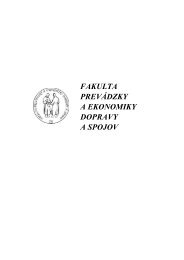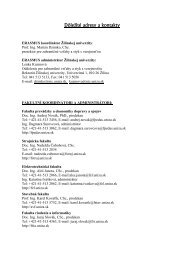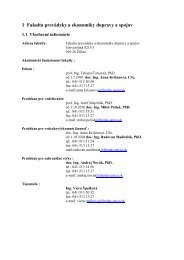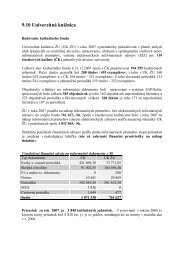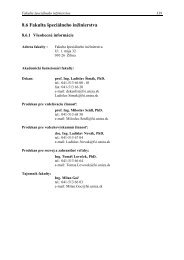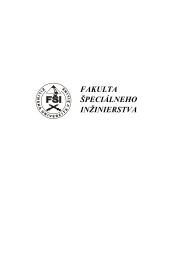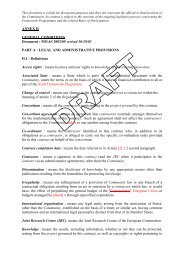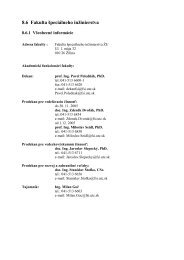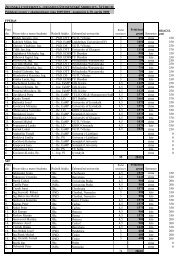posudzovanie vplyvu automobilovej dopravy na - Žilinská univerzita
posudzovanie vplyvu automobilovej dopravy na - Žilinská univerzita
posudzovanie vplyvu automobilovej dopravy na - Žilinská univerzita
You also want an ePaper? Increase the reach of your titles
YUMPU automatically turns print PDFs into web optimized ePapers that Google loves.
C O M M U N I C A T I O N S<br />
I S<br />
minimum reduction efficiency of 42% was registered at the highest<br />
SV of exhaust gas flowing through the converter, <strong>na</strong>mely at 78 <br />
10 3 h 1 . The total efficiency of NO x reduction was higher at<br />
lower SV values, and at SV of 30 10 3 h 1 an efficiency of 77,5%<br />
was obtained.<br />
The results obtained lead to a conclusion that both methods<br />
implemented, i.e. the SNR and the SCR have a significant influence<br />
on the total efficiency of NO x reduction in the exhaust gas<br />
of the engine. As at certain conditions of NO x reduction process<br />
(with the post-injection of diesel fuel into the engine cylinder)<br />
there are some limitations affecting the possibility of influencing<br />
the efficiency of thermal reduction, the development work on the<br />
optimisation of catalytic converters, and consequently on the<br />
improvement of the SCR process, should be intensified.<br />
4.4. The influence of exhaust gas temperature<br />
at the converter<br />
The investigation of the influence of exhaust gas temperature<br />
on the efficiency of NO x reduction was conducted at a constant<br />
engine velocity n 1600 r.p.m., and at a constant engine torque<br />
T 80 Nm. The following parameters were also fixed: static injection<br />
timing of main fuel dose (27° BTDC), start angle of fuel postinjection<br />
100° ATDC), the main fuel dose q 1 76 mm 3 /cycle,<br />
and the additio<strong>na</strong>l fuel dose q 2 20 mm 3 /cycle. The test stand was<br />
equipped with an exhaust gas cooler to adjust the temperature of<br />
exhaust gas before the converter in the range of 260 to 460 °C.<br />
Fig. 10 shows that the converter used in the investigation featured<br />
the highest catalytic activity in terms of NO x reduction at<br />
exhaust temperatures approximately between 380 °C and 460 °C,<br />
providing the highest NO x reduction efficiency ranging from 25%<br />
to 44%. At temperatures between 260 °C and 360 °C, however, the<br />
efficiency of NO x reduction in the converter was negative, which<br />
means that the converter lost its catalytic function in the NO x<br />
reduction process and became an NO x “generator”. This was caused<br />
by reactions opposite to the NO x reduction, intensified at lower<br />
exhaust gas temperature. Nitrogen oxides were produced mainly<br />
from diesel fuel constituents containing nitrogen (additives augmenting<br />
the cetane number) and from radicals such as, for example,<br />
CH 2<br />
●, CNO ● , HCN ● .<br />
4.5. The influence of diesel fuel group composition<br />
Three diesel fuel grades differing in chemical composition<br />
were a<strong>na</strong>lysed. The properties of the fuels are collected in Table 1.<br />
Three main groups of hydrocarbons were distinguished in the diesel<br />
fuel: aromatic hydrocarbons, ethylenic hydrocarbons (olefins), and<br />
saturated hydrocarbons (paraffins and <strong>na</strong>phtenes).<br />
An investigation of the influence of diesel fuel group composition<br />
on the NO x reduction in the exhaust gas was conducted at<br />
a constant engine velocity n 1600 r.p.m. and a constant torque<br />
T 60 Nm. The main fuel dose q 1 60 mm 3 /cycle, the post-injection<br />
fuel dose q 2 20 mm 3 /cycle, the static injection timing of main<br />
fuel dose was 27° BTDC, and the start angle of fuel post-injection<br />
100° ATDC.<br />
Fig. 11 shows percentages of these hydrocarbons in the fuels<br />
used. The highest value of the total efficiency of NO x reduction<br />
C 54 % was obtained for fuel “3”, and the lowest value (48%)<br />
was obtained for fuel “1” (Fig. 12). The reason was a high NO x<br />
reduction efficiency achieved in the converter for fuel “3” due to<br />
NOx selective catalytic reduction, as shown in Fig. 13.<br />
Fig. 11. Contents of hydrocarbon groups in the fuels used<br />
Fig. 10. The influence of exhaust gas temperature before the converter<br />
on the efficiency of NO x catalytic reduction in a Cu/ZSM-5 converter<br />
Fig. 12. The influence of diesel fuel type on the total efficiency<br />
of NO x reduction<br />
The highest efficiency of NO x reduction in the catalytic converter<br />
SCR 42% was obtained for fuel “3” (Fig. 13).<br />
32 ● KOMUNIKÁCIE / COMMUNICATIONS 1/2003



